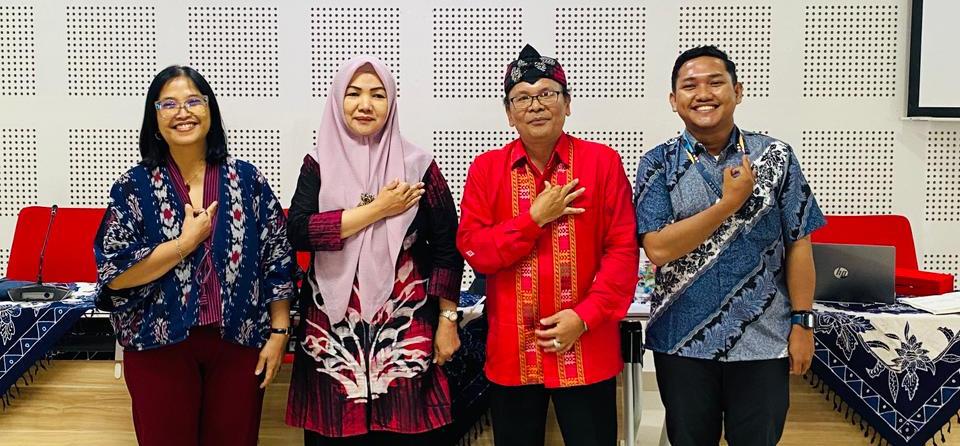The Dynamics of Indonesian Language in the Digital Era: Between Creativity and Civility

YOGYAKARTA — The transformation of the Indonesian language in the digital era took center stage during a public lecture titled “The Transformation of Indonesian Language and Digital Media” held at the Faculty of Cultural Sciences, Universitas Gadjah Mada (FIB UGM), on Monday, October 20, 2025. The event, hosted in Room S709 of the Soegondo Building, featured three prominent speakers: Prof. Dr. Munira Hasyim, M.Hum (Universitas Hasanuddin), Dr. Bernadette Kushartanti, M.Hum (Universitas Indonesia), and Dr. Sailal Arimi, M.Hum (Universitas Gadjah Mada).
In her presentation titled “The Transformation of Indonesian Language in the Digital Era: Between Linguistic Creativity and the Challenge of Civility”, Prof. Munira Hasyim invited participants to view linguistic phenomena on social media not as deviations, but as meaningful social practices and expressions of identity.
“Indonesian is no longer confined to textbooks or academic spaces—it pulses through social media, among millions of thumbs typing in virtual spaces,” Prof. Munira began.
She emphasized that social media has become a primary arena for constructing social identity, especially among youth. The language used on platforms like TikTok, Instagram, WhatsApp, and X (formerly Twitter) reflects new forms that deviate from standard norms but showcase linguistic vitality and creativity.
Linguistic Phenomena
Prof. Munira mapped four key phenomena in digital language transformation:
Acronyms and Abbreviations: Words like bucin (budak cinta), mager (malas gerak), japri (jalur pribadi), and gercep (gerak cepat) illustrate linguistic economy adapted to the fast pace of social media communication.
Code-Mixing with English: Phrases like “literally gabisa move on” or “healing dulu biar nggak overthinking” reflect lexical shifts and global identity markers.
Orthographic Play and Visual Expression: Random capitalization, letter repetition (gemesss, capekkk), emojis, and emoticons serve as emotional and attitudinal cues in text-based communication.
Profanity and Dysphemism: She also warned of the rise in hate speech and dysphemism in digital spaces, which can erode norms of linguistic politeness.
Youth as Drivers of Change
According to the 2024 APJII survey, Indonesia had 221.6 million internet users—79.5% of the population. The majority of active social media users are aged 15–30, making them the main agents of linguistic change. “Youth use language as a medium to assert identity and build virtual community solidarity,” Prof. Munira explained.
She cited fandom terms like bias, comeback, and stan as examples of how digital language fosters new social and cultural bonds.
Sociocultural Impact
The digital transformation of language brings dual impacts:
Positive: Enriches vocabulary and language variation, enhances linguistic creativity, and demonstrates the adaptability of Indonesian.
Negative: Clashes with formal norms, declining awareness of standard language, and potential miscommunication across contexts.
Prof. Munira illustrated this with contrasting examples of informal digital expressions (“dah nyampe niih”, “yg penting happyyy”) versus formal equivalents (“Aku sudah sampai”, “Yang penting bahagia”), highlighting the need for pedagogical responses to register shifts.
Digital Language Literacy
Quoting UNESCO (2021), Prof. Munira emphasized that digital literacy must include:
Critical Understanding of communication contexts
Cultural Awareness in language use
Ethical Communication that upholds civility
She concluded that language transformation on social media is a complex phenomenon, not merely a deviation from linguistic norms. Rather, it reflects meaningful social practices where youth creatively use language resources to shape identity and strengthen group solidarity.
While this evolution enriches vocabulary, fosters multimodal literacy, and boosts linguistic creativity, it also presents challenges—such as the seepage of vernacular forms into formal contexts and the erosion of politeness norms and standard language awareness.
Pedagogical Response: Register-Switch Model
To address these dynamics, Prof. Munira proposed a pedagogical approach that not only appreciates digital creativity but also cultivates register awareness. The Register-Switch Pedagogy model enables youth to shift between informal and formal varieties depending on communicative context.
This approach allows expressive digital identities to coexist with standard language competence, ensuring that Indonesian remains a unifying national language while adapting to the times.
Strategic Recommendations
For Educators
Integrate authentic social media examples into Indonesian language instruction. Develop activities that train students to switch registers between colloquial and formal language based on communicative context.
For Researchers
Conduct longitudinal studies to track language changes on social media and their impact on formal language competence. Develop comprehensive, interdisciplinary analytical frameworks to understand these phenomena.
For Policymakers
Formulate contextual digital and language literacy policies that accommodate youth creativity while safeguarding the integrity of standard Indonesian. These policies must be adaptive to technological and cultural shifts in digital communication.
For Youth
Cultivate contextual language awareness. Understand when to use informal versus formal registers based on the situation and communicative goals. This ensures self-expression without compromising linguistic civility.